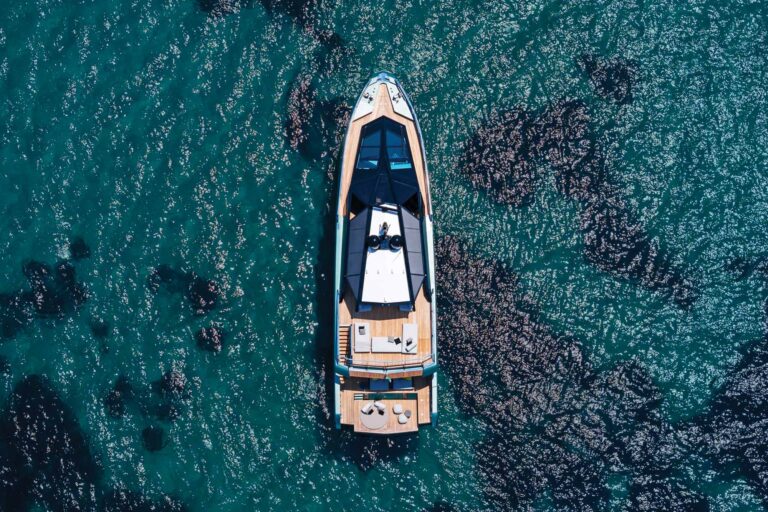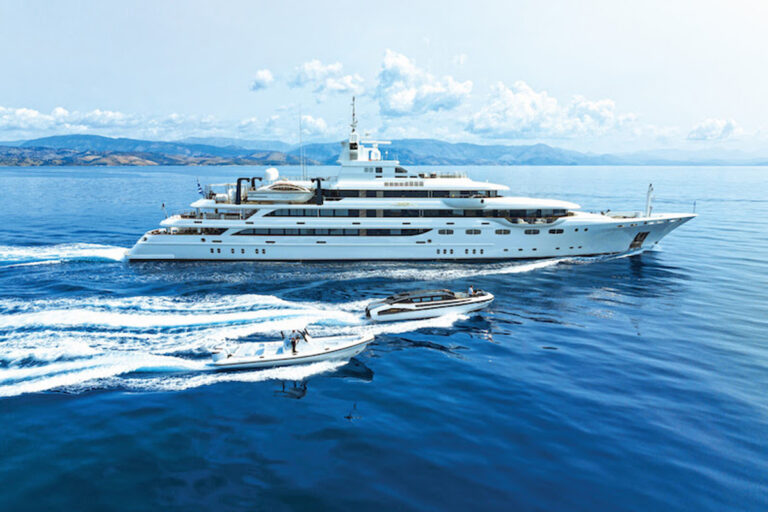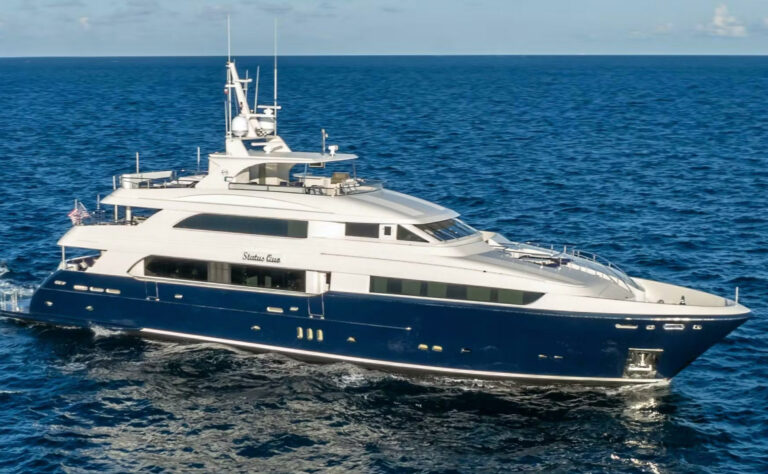Every class of vessel has an ideal size, give or take a few feet. A convertible for chasing sailfish seems perfect around 40 feet, while an 80-foot semi-displacement motoryacht is nicely suited for cruising the Bahamas. It is here, in the design sweet spot, that the new Jupiter 31 Open resides.
The 31 is sized to accommodate four anglers, but she can also be fished single-handedly. She has an enclosed head for the discreet and carries enough fuel for serious cruisers and fishermen. She also offers uncommonly quiet, efficient performance when fitted with a pair of Yamaha’s new 225 hp F225 four-stroke outboards.
I have been a fan of the 31 since the original was introduced in 1989. At the time, the Jupiter, Florida-based company built about nine boats a year. Since 1999, Carl Herndon, an industry veteran and founder of Blackfin Yacht Corporation, has been in charge, running the company as a subsidiary of Jupiter Marine International Holdings, a publicly traded company that also owns Phoenix Yacht Corporation. Herndon increased production of the 31 to about 80 boats a year and redesigned the company’s 27-foot model in 2000.
When he set about refining the 31 for 2002, he based his effort on his own experience with the boat, and on customer input.
“Our intention was to make the 31 more user-friendly without compromising her pedigree,” he said.
In my view, Herndon achieved his goal. The new 31 is a compliment to the mark and shares the same tasteful lines as her predecessor. She is distinct among her competition, as she is conservative by comparison. Her sheer has a gentle reverse sweep, and her stem rake is not exaggerated like that on some of her kind. She has a conventional transom with a custom engine bracket/dive platform, which I find more appealing and no less practical than the popular integral reverse transoms. While she has a high-performance hull design, she is no morphed muscle boat, and she sports no garish graphics. She will remain pleasing to the eye as trendier designs age.
“Our boats are designed with features that will appeal to those who are serious about family fishing and cruising,” Herndon said.
With the latter in mind, the 31 is also available with an attractive low-profile cuddy that includes a V-berth/dinette and a vanity with sink. A microwave, a refrigerator, and air conditioning can be added. This area offers a welcome escape from the weather and is suitable for an overnight cruise.
Herndon’s improvements to the 31 are subtle, but they do make a difference. Among the most obvious is the new console design, which has a helm position offset to port. This makes sense, allowing a more comfortable allocation of space on the bolster-style seating. Hydraulic steering is standard, and the wheel is adjustable.
The instrument panel has been reconfigured with an integral electronics area that has a removable/lockable Plexiglas cover. This design eliminates the need for an overhead box and the neck strain associated with such a layout.
In addition to the bolster seating, there is a bench seat forward of the console with stowage beneath. Removable transom bench seating can also be fitted. A new one-piece console door is sturdier than the old two-piece arrangement, and the 6 feet, 2 inches of headroom within enhances access to the vanity and sink/shower. An electric toilet can be fitted.
The console’s interior is finished with a full liner, and hinged vented doors allow access to the battery compartment, which is thoughtfully located well above the bilges. Ground tackle stowage is improved by a top-loading design with an anchor mount. Those familiar with the 31 will be pleased to learn that bilge access has been improved, with a dedicated hatch for bilge pumps and float switches.
The 31 has always been well endowed in terms of fishing. She has a 50-gallon live well in the sole and a 30-gallon stand-up live well at the transom that eases pitching bait in a pinch. Additional stowage beneath the sole includes two rod lockers and a 465-quart insulated fishbox. The cockpit is plumbed with fresh- and saltwater washdowns, and there is a small bait prep area. Those who fish and cruise the Bahamas may opt for a 50- or 105-gallon auxiliary fuel tank in addition to the 31’s standard 260-gallon capacity.
Most impressive on the 31 are her construction and big boat-style systems. Each 31 is laid up by hand with a blend of multidirectional stitched fiberglass reinforcement. The bottom is solid, and the hull sides, decks and console are cored with closed cell foam. A closely spaced one-piece egg crate-style framing system is molded in fiberglass and bonded to the boat. The 3 1/2-inch thick transom is a fiberglass/high-density foam composite. Aluminum fuel tank(s) are foamed in place, and voids in the bilges are foam-filled before the cockpit, deck and hull are mated. Bilge areas are fitted with liners or finished neatly with gelcoat.
The 31’s plumbing and electrical systems are well above average for a boat of her type. Access to fresh- and raw-water systems is centralized, and an electrical panel behind a Plexiglas door in the console is fitted with labeled breakers. Wiring is numbered. Contacts are made via ring connectors with heat-shrink insulation.
Her hull has a deep-V form with a fine 60-degree entry and 24-degree running surface. Bottom strakes control spray forward and define the lifting surface at speed. Chine flats, with a slight reverse, increase in width to about 3 inches aft. There is a centerline flat or pad at the transom that adds lift and helps maintain a clean flow of water to the props.
While these attributes are fairly conventional, the success of a high-performance design such as the 31 depends more on the melding of such features with the proper beam, weight, balance and power. In this area, the 31 excels. Her dry weight of 6,690 pounds is light, but not too light. Her 9-foot, 6-inch beam is appropriate for her length. During our sea trial, she planed easily without excessive bow rise and trimmed nicely at speed with no bad habits. The dry, comfortable ride she delivers is what has made her so popular.
I have paid the price of owning big outboards on big boats, and have waited a long time for four-strokes to climb the horsepower ladder. Yamaha’s new 60-degree V6 F225 is an impressive piece of hardware. While it weighs about 100 pounds more than its two-stroke cousin, such a penalty on boat the size of the 31 is of little consequence. Our sea trial yielded a top speed of 40.3 knots at 5500 rpm with a fuel burn of 36 gallons per hour, according to the Yamaha instrumentation. According to Jupiter, the top speed of the 31 with Yamaha 250 hp EFIs-a popular two-stroke option-is 46 knots with a fuel burn of 53 gallons per hour.
The 31 planed off in 7 seconds and reached full rpm in 20 seconds. Perhaps that’s not quite as quick as a two-stroke, but it’s not at all bad. In my view, the premium for the F225s (about $6,000 for the pair on the 31) is a bargain for Yamaha’s quiet, efficient, four-stroke power.
Base price for the 31, powered by a pair of Yamaha F225s, is $129,970. Fully rigged (as tested) with a factory T-top, electronics and a rocket launcher, expect to pay around $155,000. This is pricey for an open design, but when compared with other high-quality boats of this type, the 31 is quite competitive.
She was a great boat to begin with. Thanks to Herndon’s experienced hand, she’s even better now.
_Contact: Jupiter Marine International, (941) 729-5000; __www.jupitermarine.com__._









